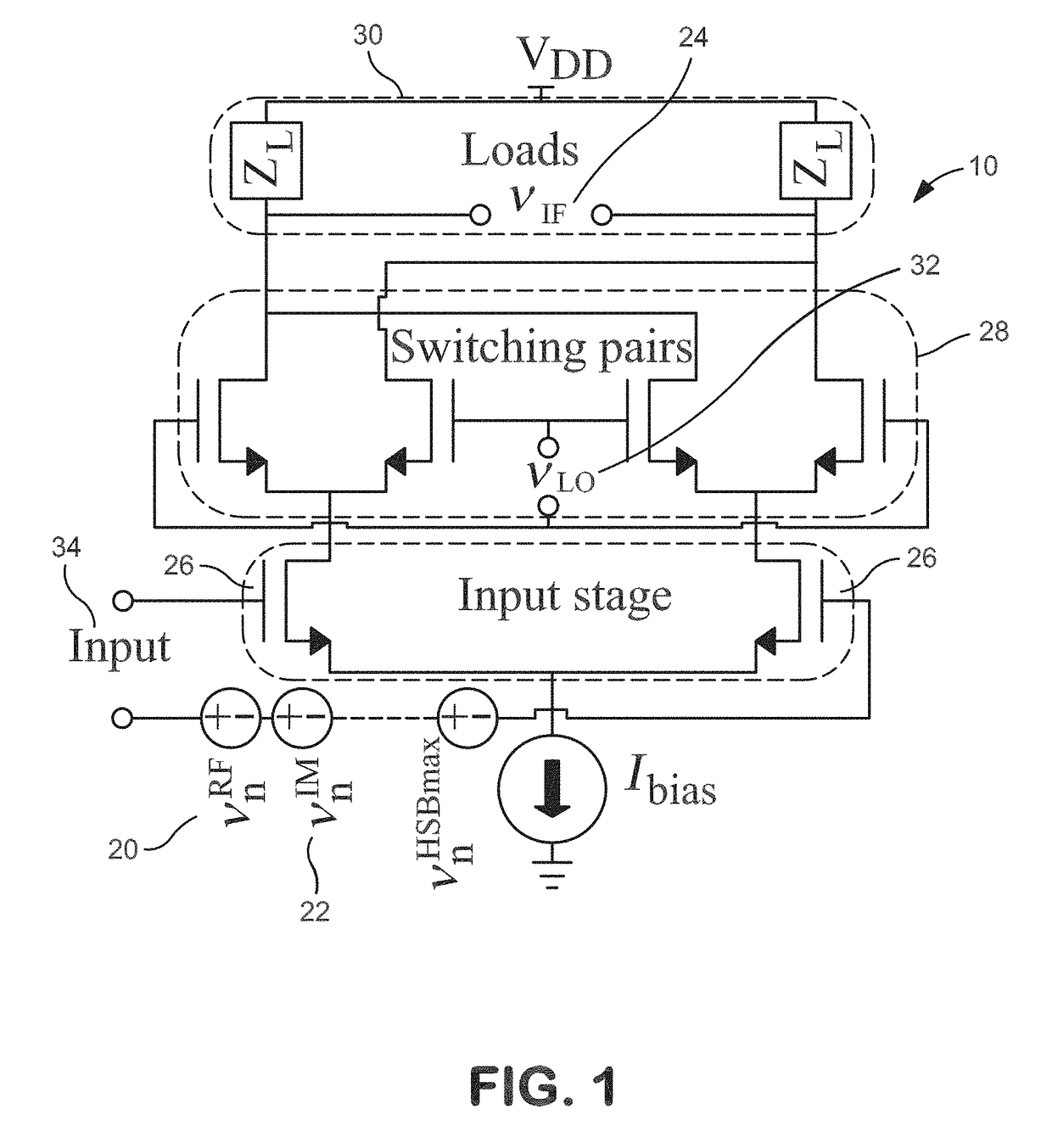Method and System for Extraction of Noise Parameters of Nonlinear Devices
a nonlinear device and noise parameter technology, applied in the direction of demodulation, transmission monitoring, electrical equipment, etc., can solve the problems of reducing the sensitivity of the signal, the difficulty of signal detection, and the poor noise figures of the mixer, so as to reduce the noise factor of the mixer
- Summary
- Abstract
- Description
- Claims
- Application Information
AI Technical Summary
Benefits of technology
Problems solved by technology
Method used
Image
Examples
example 1
Mixer Noise Simulation
[0076]The purpose the following simulations is to determine whether the noise parameters proposed in Equation 7 can be measured using the procedure in described herein (see FIG. 5). A Gilbert cell mixer was designed in IBM 0.13-μm CMOS as shown in FIG. 1. The mixer had an LO of 2.4 GHz, RF of 1.9 GHz, and an IF of 500 MHz. The RF port and IF port were terminated with ideal baluns for single-ended simulations. A harmonic balance simulation of the entire measurement procedure was carried out in Agilent's Advanced Design System (ADS). This harmonic balance simulation considers sources of noise of each component in FIG. 5, and treats the mixer in FIG. 1 as a “black box.” The particular design in FIG. 1 is provided as an example so that the noise behavior of the DUT used to test the measurement setup could be reproduced.
[0077]Table I displays values of the “measured” VC-parameters, receiver properties, and noise source properties. Since the device is an active mixer...
example 2
Experimental Measurements
[0084]Measurements of noise parameters of two commercial Gilbert cell mixers, Analog Devices ADL5801 and Linear Technology LTC5593, are discussed in this example.
A. Experimental Setup
[0085]S-parameter measurements were performed with a PNA-5242A VNA and an N4691-60004 calibration kit. All S-parameters were averaged 32 times. The VC-parameters were measured with the same VNA utilizing the frequency offset and vector-mixer / converter (VMC) measurement options 080 and 083. The vector conversion parameter measurement set up included a Reference Mixer (mini Circuits ZX05-153LH+) and a 850-MHZ lowpass filter, a Calibration Mixer (mini Circuits ZX05-153LH+) and a 850-MHZ lowpass filter, a DUT (Linear Technology LTC5593), and DUT (Analog Devices ADL5801). These allowed for vector and scalar calibrated frequency converter measurements [22]-[24]. Option 083 suggests that VMC measurements be performed on devices with high isolation (>20dB) [23], which is appropriate for...
example 3
Comparative Example
[0097]A mixer measurement procedure was reported in L. D'Addario, “Noise parameters of SIS mixers,” IEEE Transactions on Microwave Theory and Techniques, vol. 36, no. 7, pp. 1196-1206, 1988, which is incorporated by reference herein in its entirety for comparison. The procedure herein is compared to this reported procedure. However, the approach in D'Addario, 1988 was not as complete, which does not allow for a direct comparison. In addition, some important information, such as signal-source impedances for the IM sideband that would be needed for a direct comparison, was not reported in the reference. While D'Addario does not solve for all HSB noise parameters independently, the work in this reference serves as a proof of concept for the proposed measurement system, as it demonstrates that a set of noise parameters exists for each HSB.
[0098]Analysis of FIGS. 1(c) and (d) from Addario shows the similarities and differences between our measurement procedures. The pr...
PUM
 Login to View More
Login to View More Abstract
Description
Claims
Application Information
 Login to View More
Login to View More - R&D
- Intellectual Property
- Life Sciences
- Materials
- Tech Scout
- Unparalleled Data Quality
- Higher Quality Content
- 60% Fewer Hallucinations
Browse by: Latest US Patents, China's latest patents, Technical Efficacy Thesaurus, Application Domain, Technology Topic, Popular Technical Reports.
© 2025 PatSnap. All rights reserved.Legal|Privacy policy|Modern Slavery Act Transparency Statement|Sitemap|About US| Contact US: help@patsnap.com



